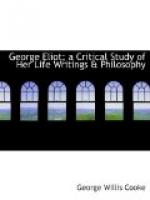scenes of the second book are so fragmentary and unconnected
with the remainder of the story as to help it but little.
In the middle of
Adam Bede are several chapters
devoted to the birthday party, which are quite unnecessary
to the development of the action.
Daniel Deronda
contains two narratives which are in many respects
almost entirely distinct from each other, and the
reader is made to alternate between two worlds that
have little in common. There is much of the improbable
in the account of the Transome estate in
Felix Holt,
while the closing scenes in the life of Tito Melema
in
Romola are more tragical than natural.
Yet these defects are incidental to her method and
art rather than actual blemishes on her work.
For the most part, her work is thoroughly unitary,
cause leads naturally into effect, and there is a moral
development of character such as is found in life itself.
Her plots are strongly constructed, in simple outlines,
are easily comprehended and kept in mind, and the
leading motive holds steadily through to the end.
Her analytical method often makes an apparent interruption
of the narrative, and the unity of purpose is frequently
developed through the philosophic purport of the novel
rather than in its literary form. Direct narrative
is often hindered, it is true, by her habit of studying
the remote causes and effects of character, but she
never wanders far enough to forget the real purpose
had in view. She holds the many elements of her
story well under command, she concentrates them upon
some one aim, and she gives to her story a tragic
unity of great moral splendor and effect. Even
the diverse elements, the minute side-studies and
the profuse comments, are all woven into the organic
structure, and are essential to the unfoldment of the
plot. They seem to be quite irrelevant interruptions
until we look back upon the completed whole and study
the perfected intent of the story. Then we see
how essential they are to the epic finish of the novel,
and to that total effect which a work of genius creates.
Then it is seen that a dramatic unity and well-studied
intent hold together every part and make a completed
structure of great beauty.
Her dramatic skill is great, and her dialogues thoroughly
good. Her characters are full of power and life,
and stand out as distinct personalities. The
conversation is sprightly, strong and wise. Probably
no novelist has created so many clearly cut, positive,
intensely personal characters as George Eliot, and
this individualism is depicted as acting within social
and hereditary limits; hence dramatic action is constantly
arising. Shakspere and Browning only surpass her
in dramatic power, as in the creation of character.
Yet her method of producing character differs essentially
from that of Shakspere, Homer and all the great creators.
She describes character, while they present it.
Homer gives no description of Helen; but of her beauty
and her person we learn all the more because we are
left to find them out from the influence they produce.
We know Hamlet because he lives before us, and impresses
his personality upon every feature of the great drama
in which he appears. George Eliot’s manner
is to describe, to minutely portray, and to dissect
to the last muscle and nerve.




